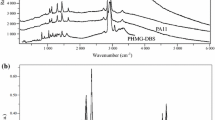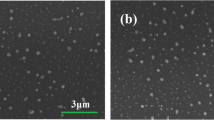Abstract
Polyaniline is an important conducting polymer with numerous applications and its surface properties, and consequently functionality, can be significantly influenced by bacterial biofilm. This paper represents the first ever study of biofilm formation on surface of polyaniline salt, polyaniline base and polyaniline doped with biologically active poly(2-acrylamido-2-methyl-1-propanesulfonic acid) (PAMPSA) and phosphotungstic acid. The surface energy and conductivity of the films were measured and correlated to capability of selected strains of biofilm-positive bacteria and filamentous fungi to form a biofilm thereon. It was observed that polyaniline salt did not inhibit the growth of microorganisms, whereas polyaniline doped with PAMPSA exhibited a notable effect against growth of biofilm for all the bacterial strains used. The results advance present knowledge of biofilm formation on polyaniline.


Similar content being viewed by others
References
An YH, Friedman RJ (2000) Handbook of bacterial adhesion principles, methods, and applications. Humana Press, Totowa. ISBN 9781592592241
Baldissera AF, de Miranda KL, Bressy C, Martin C, Margaillan A, Ferreira CA (2015) Using conducting polymers as active agents for marine antifouling paints. Mater Res 18:1129–1139. doi:10.1590/1516-1439-261414
Binkauskiene E, Lugauskas A, Bukauskas V (2013) The mycological effect on morphological, electrochemical and redox properties of the polyaniline surface. Surf Interface Anal 45:1792–1798. doi:10.1002/sia.5324
Bober P, Humpolicek P, Pachernik P, Stejskal J, Lindfors T (2015) Conducting polyaniline based cell culture substrate for embryonic stem cells and embryoid bodies. RSC Adv 5:50328–50335. doi:10.1039/c5ra07504a
Chauhan NPS, Ameta R, Ameta R, Ameta SC (2010) Biological activity of emeraldine bases of polyaniline. J Indian Counc Chem 27:128–133
Conato M, Sumera F (2012) Biodegradable polyesters and polyamides from difunctionalized lauric and coconut fatty acids. J Polym Environ 20:217–223. doi:10.1007/s10924-011-0397-y
Deshpande PP, Vathare SS, Vagge ST, Tomšík E, Stejskal J (2013) Conducting polyaniline/multi-wall carbon nanotubes composite paints on low carbon steel for corrosion protection: electrochemical investigations. Chem Pap 67:1072–1078. doi:10.2478/S11696-012-0273-9
Eroshenko D, Morozov I, Korobov V (2015) The role of plasma, albumin, and fibronection in Staphylococcus epidermidis adhesion to polystyrene surface. Curr Microbiol 70:846–853. doi:10.1007/s00284-015-0796-8
Garrett TR, Bhakoo M, Zhang Z (2008) Bacterial adhesion and biofilms on surfaces. Prog Nat Sci 18:1049–1056. doi:10.1016/j.pnsc.2008.04.001
Gizdavic-Nikolaidis MR, Bennett JR, Swift S, Easteal AJ, Ambrose M (2011) Broad spectrum antimicrobial activity of functionalized polyanilines. Acta Biomater 7:4204–4209. doi:10.1016/j.actbio.2011.07.018
Gizdavic-Nikolaidis MR, Bennett J, Zujovic Z, Swift S, Bowmaker GA (2012) Characterization and antimicrobial efficacy of acetone extracted aniline oligomers. Synth Metal 162(13–14):1114–1119
Gribkova OL, Nekrasov AA, Trchova M, Ivanov VF, Sazikov VI, Razova AB, Tverskoy VA, Vannikov AV (2011) Chemical synthesis of polyaniline in the presence of poly(amidosulfonic acids) with different rigidity of the polymer chain. Polymer 52:2474–2484. doi:10.1016/j.polymer.2011.04.003
Humpolicek P, Kucekova Z, Kasparkova V, Pelková J, Modic M, Junkar I, Trchová M, Bober P, Stejskal J, Lehocký M (2015) Blood coagulation and platelet adhesion on polyaniline films. Colloids Surf B 133:278–285. doi:10.1016/j.colsurfb.2015.06.008
Illing G, Hellgardt K, Wakeman RJ, Jungbauer A (2001) Preparation and characterisation of polyaniline based membranes for gas separation. J Membr Sci 184:69–78. doi:10.1016/S0376-7388(00)00606-2
Jia Q, Shan S, Jiang L, Wang Y, Li D (2012) Synergistic antimicrobial effects of polyaniline combined with silver nanoparticles. J Appl Polym Sci 125(5):3560–3566
Kalendová A, Sapurina I, Stejskal J, Veselý D (2008) Anticorrosion properties of polyaniline-coated pigments in organic coatings. Corros Sci 50:3549–3560. doi:10.1016/j.corsci.2008.08.044
Kelly FM, Meunier L, Cochrane C, Koncar V (2013) Polyaniline: application as solid state electrochromic in a flexible textile display. Displays 34:1–7. doi:10.1016/j.displa.2012.10.001
Koutny M, Sancelme M, Dabin C et al (2006) Acquired biodegradability of polyethylenes containing pro-oxidant additives. Polym Degrad Stab 91(7):1495–1503. doi:10.1016/j.polymdegradstab.2005.10.007
Kucekova Z, Kasparkova V, Humpolicek P, Sevcikova P, Stejskal J (2013) Antibacterial properties of polyaniline–silver films. Chem Pap 97:1103–1108. doi:10.2478/s11696-013-0385-x
Kucekova Z, Humpolicek P, Kasparkova V, Perecko T, Lehocký M, Hauerlandová I, Sáha P, Stejskal J (2014) Colloidal polyaniline dispersions: Antibacterial activity, cytotoxicity and neutrophil oxidative burst. Colloid Surf B Biointerface 116:411–417
Lange U, Roznyatovskaya NV, Mirsky VM (2008) Conducting polymers in chemical sensors and arrays. Anal Chim Acta 614(1):1–26
Liang X, Sun M, Li L, Qiao R, Chen K, Xiao Q, Xu F (2012) Preparation and antibacterial activities of polyaniline/Cu0.05Zn0.95O nanocomposites. Dalton Trans 41(9):2804
Muchova M, Ruzicka J, Julinova M, Dolezalova M, Houser J, Koutny M, Bunkova L (2009) Xanthan and gellan degradation by bacteria of activated sludge. Water Sci Technol 60:965–973. doi:10.2166/wst.2009.443
Nambiar S, Yeow JTW (2011) Conductive polymer-based sensors for biomedical applications. Biosens Bioelectron 26:1825–1832. doi:10.1016/j.bios.2010.09.046
Park E, Kim H, Song J, Oh H, Song H, Jang J (2012) Synthesis of silver nanoparticles decorated polypyrrole nanotubes for antimicrobial application. Macromol Res 20(10):1096–1101
Rodrigues LR, Banat IM, Mei HC, Teixeira JA, Oliveira R, (2006) Interference in adhesion of bacteria and yeasts isolated from explanted voice prostheses to silicone rubber by rhamnolipid biosurfactants. J Appl Microb 100(3):470–480
Smyth MR, Zhao H, Wallace GG (1999) Conducting electroactive polymer-based biosensors. Trends Anal Chem 18:245–251. doi:10.1016/S0165-9936(98)00113-7
Stejskal J, Gilbert RG (2002) Polyaniline. Preparation of a conducting polymer (IUPAC Technical Report). Pure Appl Chem 74:857–867
Stejskal J (2013) Conducting polymer–silver composites. Chem Pap 67:814–848. doi:10.2478/S11696-012-0304-6
Stejskal J, Sapurina I (2005) Polyaniline: thin films and colloidal dispersions (IUPAC technical report). Pure Appl Chem 77:815–826. doi:10.1351/pac200577050815
Stejskal J, Prokeš J, Trchová M (2008) Reprotonation of polyaniline: a route to various conducting polymer materials. React Funct Polym 68:1355–1361. doi:10.1016/jreactfunctpolym.2008.06.012
Strömberg E, Karlsson S (2009) The effect of biodegradation on surface and bulk property changes of polypropylene, recycled polypropylene and polylactide biocomposites. Int Biodeterior Biodegrad 63:1045–1053. doi:10.1016/j.ibiod.2009.08.003
Szczesna-Antczak M, Kaczorowska A, Kaczorowski W, Antczak T (2014) Biomodification and biodeterioration of carbon coatings by fungal strains. Int Biodeterior Biodegrad 88:106–117. doi:10.1016/j.ibiod.2013.12.013
Wu W, Giese RF Jr, Van Oss CJ (1995) Evaluation of the Lifshitz-van der Waals/acid-base approach to determine surface tension components. Langmuir 11(1):379–382. doi:10.1021/la00001a064
Yehgambaram P, Prasad RGSV, Jakka VS, Aparna RSL, Phani AR (2013) Antifungal activity of nanostructured polyaniline combined with fluconazole. J Pharm Res 6:26–31. doi:10.1016/j.jopr.2012.11.009
Acknowledgements
This work was supported by the Ministry of Education, Youth and Sports of the Czech Republic—Programme NPU I (LO1504), and the authors also wish to thank the Internal Grant Agency (Project IGA/CPS/2015/002, IGA/CPS/2016/001). P.B. and J.S. thank the Czech Science Foundation (16-02787S) for the financial support. N.M. thanks the Czech Science Foundation (15-08287Y).
Author information
Authors and Affiliations
Corresponding author
Rights and permissions
About this article
Cite this article
Mikušová, N., Humpolíček, P., Růžička, J. et al. Formation of bacterial and fungal biofilm on conducting polyaniline. Chem. Pap. 71, 505–512 (2017). https://doi.org/10.1007/s11696-016-0073-8
Received:
Accepted:
Published:
Issue Date:
DOI: https://doi.org/10.1007/s11696-016-0073-8




